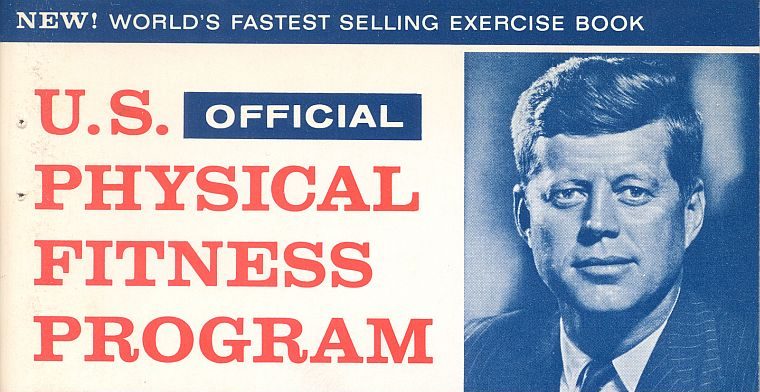
22 Dec Ah, Memories: The Presidential Fitness Challenge
The Presidential Fitness Challenge began in 1966 as the Presidential Physical Fitness Award. It became the President’s Challenge, sometimes called the Presidential Fitness Test, in 1988. In 2012, the Obama administration further modified it with the new name Presidential Youth Fitness Program (they key word here being “program.”) New awards and new challenges have been added along the way.
Whatever the federal government calls it, the youth of America have a few choice words for it — some positive and some negative. (Enjoy this selection of comments.) Exactly what was the purpose of this rite of passage, and what are YOUR memories of it?
Out-of-Shape Kids?
According to NPR, “In the 1950s, research showed Americans were out of shape and in poor health compared with their counterparts in Europe. When President Kennedy took office, he made improving the nation’s fitness a top priority of his administration.” It was Lyndon Johnson who finally launched the test. The test’s designers chose challenges to mimic physical prowess that young Americans would need to serve in the military. For example, kids had to throw a softball to show they could theoretically throw a grenade.
Kennedy wrote to Sports Illustrated to stress the need for physical fitness among America’s youth. He implemented precursors to the official challenge (see photo above). It was Lyndon Johnson who finally launched the test. The test’s designers chose challenges to mimic physical prowess that young Americans would need to serve in the military. For example, kids had to throw a softball to show they could theoretically throw a grenade.
What Did the Test Entail?
In case you don’t remember the test or grew up outside the U.S. here’s the lowdown. The challenge asked students to undergo a series of tests in various physical activities. If a student placed in the top 15th percentile in every category, they received the Presidential Fitness Award. Events included running a mile, sit-ups, pull-ups, a “shuttle run,” or sprint that involved retrieving objects, and a “sit-and-reach” flexibility test.
Why Did Some Kids Hate It?
Your score was measured as a percentile of your peers across the country. You had to score in the top 85th percentile. That means kids were competing against each other so, automatically, only the top 15% could succeed. It’s understandable that many kids reacted unfavorably.
Schools generally weaved the test into PE class, already a traumatic experience for many. Presidential Fitness Test or no Presidential Fitness Test, gym class put kids’ physical abilities on display for their classmates. PE teachers have a reputation for harshness, even humiliation. Many adults today recall having to finish the dreaded mile run while their faster classmates looked on. Some remember teachers yelling to motivate them. The sit-up test required a partner to hold your feet, guaranteeing an audience of at least one. Anyone insecure with his or her body or abilities could quickly feel like climbing up that big rope and hiding in the rafters.
Also, you had to score well in every category. Some kids brought prior conditioning that made them better at some things that others. Kids (mostly girls) who did dance and gymnastics were usually good at the flexibility test. Kids who played soccer could usually nail the shuttle run. Some adults recall now that they succeeded at all but one element of the test, which still leaves them frustrated years later.
Did Anyone Love It?
Positive memories are harder to come by. Blogger Rita Arens set out, in 2009, to write an article about the test. She says, “I started out with every intention of writing about kids and the Presidential Physical Fitness Test, but what I found, what I found! Was a whole bunch of adults with post-traumatic stress about the test.”
The test at least picked up some star power when George H.W. Bush appointed Arnold Schwarzenegger chairman during his presidency.
Ostensibly, those kids who passed the test and earned their patch felt pretty good about it. Perhaps for kids who succeeded physically but didn’t fare as well academically, the fitness test was a welcome chance to shine. However, educators, students, and lawmakers seemed to agree that the program needed a 21st century overhaul.
What is it Like Now?
NPR explains, “The new program is more than just a fitness test. It’s a teaching tool to help students understand fitness and develop habits they can use to get healthier.” So, for example, the test measures whether a child can keep a pace while running, rather than testing how long it takes him/her to run a mile.
The new version also encourages good nutrition, asking participants to set goals for changing their dietary habits. An example would be “Half my plate was filled with fruits and vegetables.” A companion website, Fitness.gov, offers activity and nutrition tips.
In 2014, the CDC conducted a study of 600 young teenagers to measure fitness. Instead of putting them through a series of trials, they simply measured how well the heart and lungs supplied blood to muscles while they ran on a treadmill. The results weren’t good. 58% were considered physically unfit. And, that’s up ten percentage points from 2000. So whether the revamped presidential program can turn the tide remains to be seen. But anyone who suffered through the test as a youth probably has their own prediction on that.
Did you take the Presidential Fitness Challenge? What do you remember about it?




No Comments